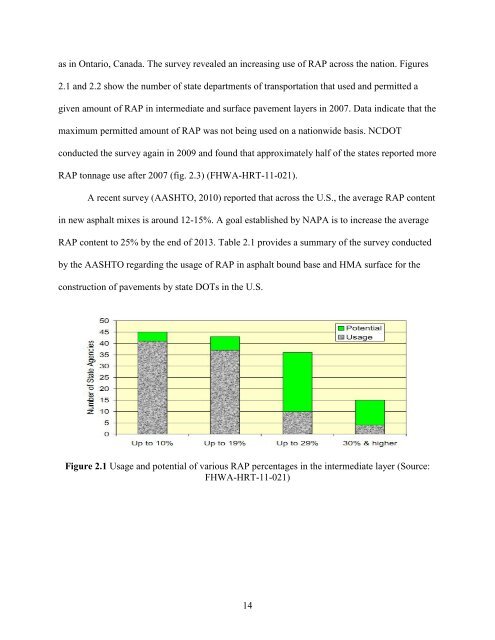Onsite Use of Recycled Asphalt Pavement Materials and Geocells to ...
Onsite Use of Recycled Asphalt Pavement Materials and Geocells to ...
Onsite Use of Recycled Asphalt Pavement Materials and Geocells to ...
You also want an ePaper? Increase the reach of your titles
YUMPU automatically turns print PDFs into web optimized ePapers that Google loves.
as in Ontario, Canada. The survey revealed an increasing use <strong>of</strong> RAP across the nation. Figures<br />
2.1 <strong>and</strong> 2.2 show the number <strong>of</strong> state departments <strong>of</strong> transportation that used <strong>and</strong> permitted a<br />
given amount <strong>of</strong> RAP in intermediate <strong>and</strong> surface pavement layers in 2007. Data indicate that the<br />
maximum permitted amount <strong>of</strong> RAP was not being used on a nationwide basis. NCDOT<br />
conducted the survey again in 2009 <strong>and</strong> found that approximately half <strong>of</strong> the states reported more<br />
RAP <strong>to</strong>nnage use after 2007 (fig. 2.3) (FHWA-HRT-11-021).<br />
A recent survey (AASHTO, 2010) reported that across the U.S., the average RAP content<br />
in new asphalt mixes is around 12-15%. A goal established by NAPA is <strong>to</strong> increase the average<br />
RAP content <strong>to</strong> 25% by the end <strong>of</strong> 2013. Table 2.1 provides a summary <strong>of</strong> the survey conducted<br />
by the AASHTO regarding the usage <strong>of</strong> RAP in asphalt bound base <strong>and</strong> HMA surface for the<br />
construction <strong>of</strong> pavements by state DOTs in the U.S.<br />
Figure 2.1 Usage <strong>and</strong> potential <strong>of</strong> various RAP percentages in the intermediate layer (Source:<br />
FHWA-HRT-11-021)<br />
14
















